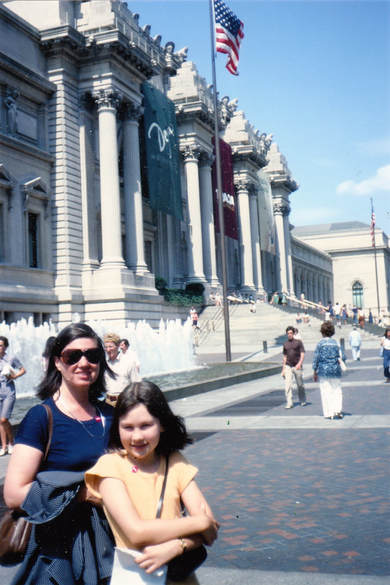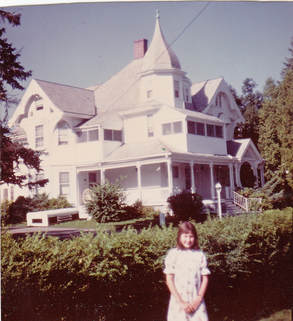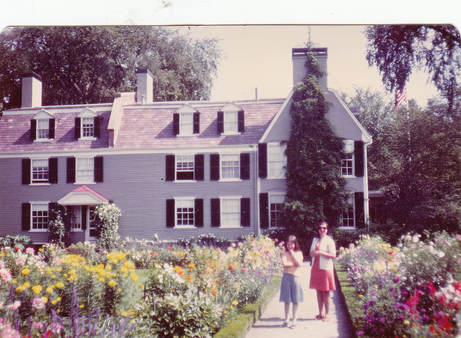 Sherrill & Simone at the Metropolitan Museum of Art, New York City
Sherrill & Simone at the Metropolitan Museum of Art, New York City "They must have been really good people," Simone said.
We were at Fruitlands, the commune started by Bronson Alcott, Louisa May's father, and others from Concord, including Nathaniel Hawthorne. Louisa May Alcott wrote about it in her journal ("I love cold water!") and later Hawthorne published a novel based on the experience. We were there in 1977, a year after the two-hundredth anniversary of the Declaration of Independence and birth of the United States. In 1976, people from all over the country traveled to the Boston Freedom Trail and other places where the revolution exploded and was won. A year later, we rationalized, it would be less crowded.
Yes, we paid our respects to the courage of the colonists and revolutionaries, but we also found ourselves spending equal time at literary landmarks—as long as we were in the neighborhood, of course. Even before we left home, I was talking about F. Scott Fitzgerald's old stomping grounds and where Poe, Whitman, and Hawthorne had lived and worked.
Sherrill gave me a look.
"You're such a romantic," she said.
"A romantic?"
She patted me on the cheek: "Don't worry about it, sweetie."
Fruitlands, as stark as the old place was, particularly resonated with us—maybe because we, too, had been part of a group that tried to start a commune. That gentle band of Transcendentalists and writers who wanted to give up the vanities of life and share everything touched our hearts. We also found a more recent literary landmark In Concord. The mystery and treasure hunt in Jane Langton's The Diamond in the Window had gripped us when we read it and here was the house described in the book, a Victorian Queen Ann with its pointed tower, standing where it was supposed to be.
Trying to stick to our patriotic agenda, we visited the Old North Church and State House in Boston, then Boston Common and Public Garden, where Simone walked up to the life-size bronze statues of Mrs. Mallard and her eight ducklings marching past the lake.
"Jack, Kack, Lack, Mack," she said, naming the ducklings, "Nack, Ouack, Pack, and Quack." When she was younger, Sherrill and I read the book Make Way for Ducklings to her so many times that we all three had memorized it.
Sherrill and Simone humored me after our visit to Independence Hall and the Liberty Bell in Philadelphia, when I wanted to visit Walt Whitman's house across the Delaware River in Camden. The streets were full of potholes and the neighborhood rundown, but it didn't seem like anything to be scared about. Eventually, we found, across from a bulky building that looked like a prison, the little house Whitman bought in 1884 and lived in until his death.
"Are you sure we should be here?" Sherrill asked as she parked in front of the narrow frame house.
I shrugged. "Why not?"
"I hope nothing happens to the car."
We didn't know then about Camden's reputation. Later, when we mentioned our visit to a friend, he blurted, "You did what?" Apparently, at that time, Camden had the highest murder rate of any city in the country.
"Well, the car survived and we survived," I replied.
Once again, Sherrill patted me on the cheek.
We had a good visit with my aunt and uncle in Arlington while we were in the Washington D. C. area, and then explored the city, from the Capitol Building to the Mint to the Smithsonian museums and the great monuments. We were touched the most by the Jefferson and Lincoln memorials, but that may have been because of the power of their words carved on the marble walls. Continuing through Virginia, we a felt a similar power at Monticello, a quiet wisdom that reflected the personality that created it.
Williamsburg was supposed to give us an idea of how people in the colonial period lived, but everything was so tidy that it was hard to see men and women and children living there, despite the pretend colonists baking bread and hammering out horseshoes.
"What I really want to do while we're in New York," Sherrill told me after we looked at the view from the top of the World Trade Center and spent several hours in the Metropolitan Museum of Art, "is go to The Cloisters."
Although she wasn't religious, the stylized boldness of Medieval art always spoke to Sherrill more than the art of the Renaissance. After the galleries of icons, carvings, and manuscript pages, plus the magnificent Unicorn Tapestries, we strolled among the museum's gardens of medieval plants, identifying some of the flowers, herbs, and trees we'd seen in the tapestries.
Oh, no, I thought, now she's going to want a medieval section in our garden.
Maybe it was a romantic notion, but before leaving New York, we had to ride through Central Park in a horse-drawn carriage. As we passed the Plaza Hotel in the open carriage, I snapped several photographs of the fountain at its entrance.
"They're not here, now, you know," Sherrill told me, patting my knee. "Not for a long time."
She'd understood that I was imagining Scott and Zelda Fitzgerald in the fountain, open champagne bottle in hand, splashing under the watchful gaze of the bronze nude in the center.
 Simone at the Diamond in the Window house in Concord
Simone at the Diamond in the Window house in Concord The next post in this series of A Marriage in Motion will skip a week and appear on Monday, September 11.
If you enjoy these posts, please share them with anyone else you think also will find them interesting. You also might enjoy reading the new bargain-priced e-edition of my 1966 North Beach novel, The Night Action. Available at Amazon and Barnes and Noble.

 RSS Feed
RSS Feed